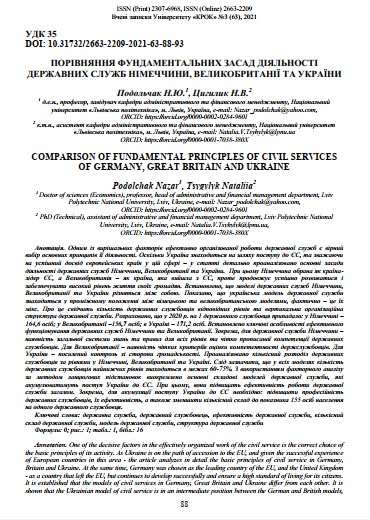COMPARISON OF FUNDAMENTAL PRINCIPLES OF CIVIL SERVICES OF GERMANY, GREAT BRITAIN AND UKRAINE
DOI:
https://doi.org/10.31732/2663-2209-2021-63-88-93Keywords:
civil service, civil servant, efficiency of civil service, quantitative composition of civil service, model of civil service, structure of civil serviceAbstract
One of the decisive factors in the effectively organized work of the civil service is the correct choice of the basic principles of its activity. As Ukraine is on the path of accession to the EU, and given the successful experience of European countries in this area - the article analyzes in detail the basic principles of civil service in Germany, Britain and Ukraine. At the same time, Germany was chosen as the leading country of the EU, and the United Kingdom - as a country that left the EU, but continues to develop successfully and ensure a high standard of living for its citizens. It is established that the models of civil services in Germany, Great Britain and Ukraine differ from each other. It is shown that the Ukrainian model of civil service is in an intermediate position between the German and British models, in fact - this is their mix. This is evidenced by the number of civil servants at the appropriate levels and the vertical organizational structure of the civil service. It is estimated that in 2020 there were 16 civil servants per 1 civil servant in Germany; in Great Britain - 156.7 people; in Ukraine - 171.2 people. The key features of the effective functioning of the civil services of Germany and Great Britain have been identified. In particular, for the German civil service - the existence of a common system of knowledge and rules for all levels and clearly defined competence of civil servants. For the United Kingdom, there are clear criteria for assessing the competence of civil servants. For Ukraine - enhanced public control. The quantitative distribution of civil servants by levels in Germany, Great Britain and Ukraine is analyzed. It should be noted that in all models the number of civil servants of the lowest levels is in the range of 60-75%. Using the factor analysis by the method of chain substitutions, the main components of the civil service models that will accumulate Ukraine's progress to the EU have been identified. At the same time, they will increase the efficiency of the civil service in general. In particular, in order to accumulate Ukraine's progress in the EU, it is necessary to: increase the professionalism of civil servants, their efficiency, as well as reduce the number of employees to 155 per capita.
Downloads
References
Державна служба: підручник : у 2 т. / Нац. акад. держ. упр. при Президентові України; редкол. : Ю. В. Ковбасюк (голова редкол.) та ін. Київ; Одеса : НАДУ. 2012. Т. 1. 372 с.
Гейвах П. Порівняльний аналіз організації державної служби Німеччини, Австрії та України. ДРІДУ НАДУ. 2012. №1. С. 163–172.
Кришень О.В. Теоретико-методологічні аспекти регіональної соціальної політики в період сучасних трансформацій: дис. … канд. наук з держ. управл.: 25.00.01. Дніпро, 2020. 241 с.
Про державну службу : Закон України прийнятий 10 грудня 2015 р. № 889-VIII. Відомості Верховної Ради України. 2016. № 4. С. 43.
Витко Т. Ю. Державний службовець в умовах реформування державного управління в Україні. Аспекти публічного управління. 2018. Т. 6. № 3. С. 39-47.
Drozd О. Civil Service Pattern in Germany and Ukraine: A Comparative Aspect. JARLE. 2017. URL: https://journals.aserspublishing.eu/jarle/article/view/1703.
Horban O., Bass V., Drozd O. Administrative-legal bases of functioning of the civil service: comparative-legal aspect. Ano-2020: Special edition. 2020. №93. P.45-60.
Jann W., Veit S. Politics and Administration in Germany. In: Kuhlmann S., Proeller I., Schimanke D., Ziekow J. (eds) Public Administration in Germany. Governance and Public Management. Palgrave Macmillan, Cham. 2021. DOI : https://doi.org/10.1007/978-3-030-53697-8_10
Орлів М. С. Розвиток вищої державної служби у Великобританії. Державне управління та місцеве самоврядування. 2017. № 33. С. 117–123.
Parry R. The United Kingdom Civil Service : A Devolving System. 2011. URL: https://www.researchgate.net/publication/290774668_The_United_Kingdom_civil_service_A_devolving_system.
Office for National Statistic. URL: https://www.ons.gov.uk/searchpublication?q=civil+service++2020
Statistishes Bundesamt. URL: https://www.destatis.de/DE/Home/_inhalt.html.
Державна служба статистики України. URL: http://www.ukrstat.gov.ua/.
Institute for government.org.uk. URL: https://www.instituteforgovernment.org.uk.
Civilservant.org.uk. URL: https://www.civilservant.org.uk/about_and_contact.html.
Національне Агенство з питань державної служби. URL: https://nads.gov.ua/.



